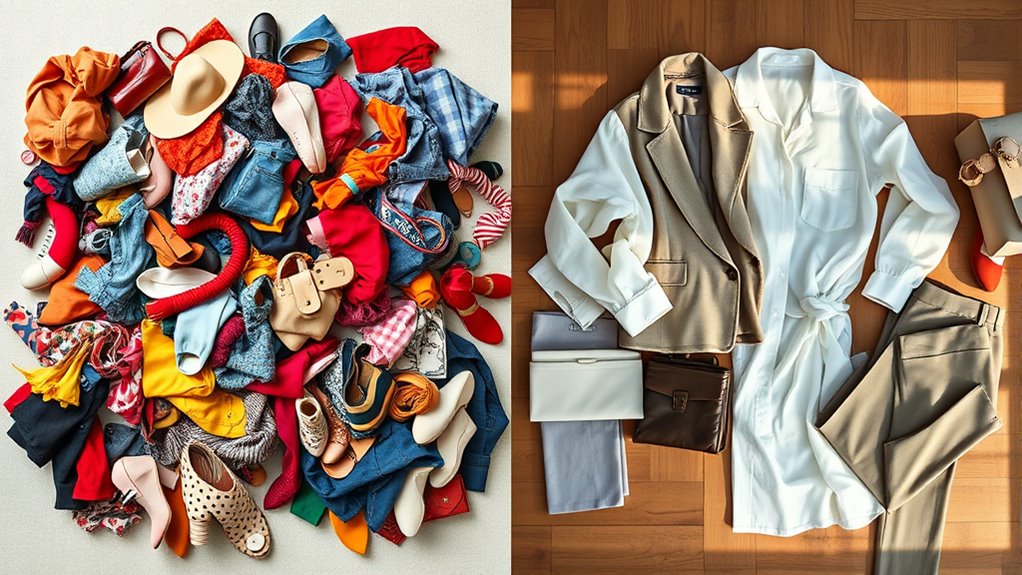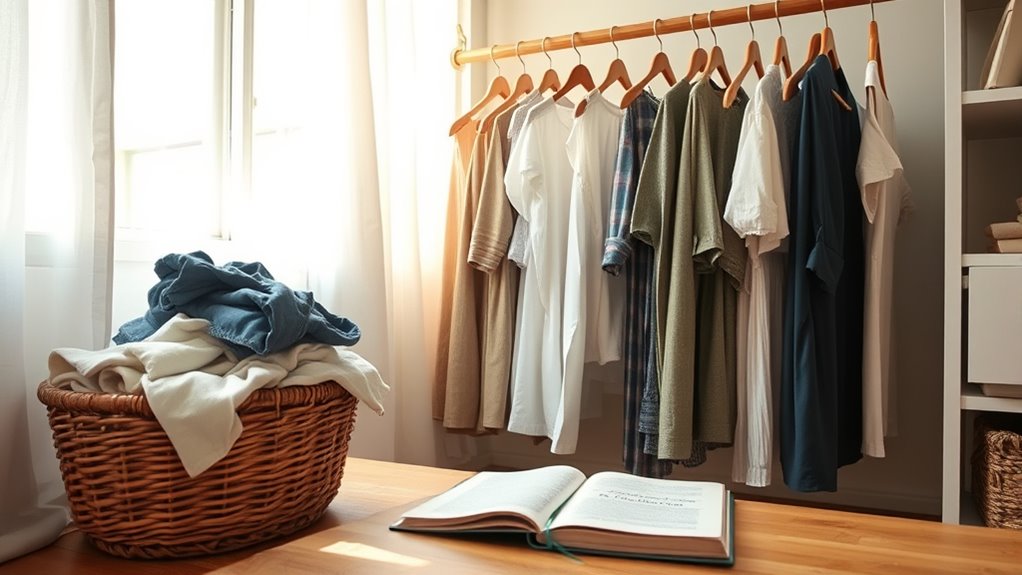Beginning a 30-day challenge helps you shift from fast fashion to a slow wardrobe by gradually adopting more ethical, sustainable choices. Focus on building a curated collection of high-quality, versatile pieces that can be mixed and matched, while questioning if new items align with your values. Incorporate secondhand shopping and prioritize brands with transparent supply chains. Keep exploring to find out how this mindful approach can transform your wardrobe and support ethical living.
Key Takeaways
- Gradually replace fast fashion items with high-quality, ethically sourced pieces aligned with your capsule wardrobe principles.
- Prioritize brands with transparent supply chains and consider secondhand shopping to extend garment lifespan.
- Question each new purchase’s fit within your slow wardrobe, focusing on versatility and durability.
- Let go of unaligned or worn-out items to make space for meaningful, well-made garments.
- Track your progress over 30 days to develop mindful consumption habits and support sustainable fashion practices.

Ever wonder if you can transform your wardrobe by making intentional, sustainable choices? The journey towards a slow wardrobe begins with understanding where your clothes come from and how they’re made. One key aspect is ethical sourcing, which ensures that garments are produced under fair labor conditions, with respect for workers’ rights and the environment. When you prioritize brands that focus on ethical sourcing, you’re supporting a system that values transparency and responsibility. Making this shift isn’t about completely overhauling your closet overnight but gradually choosing pieces that align with your values.
Transform your wardrobe with intentional, sustainable choices by prioritizing ethical sourcing and supporting transparent, responsible brands.
A great way to start is by creating a capsule collection— a small, curated wardrobe made up of versatile, high-quality pieces that can be mixed and matched effortlessly. This approach encourages you to invest in fewer, better garments rather than fast fashion items that fall apart quickly or are produced unethically. By focusing on a capsule collection, you’re not only reducing waste but also simplifying your daily routine, making it easier to dress consciously without sacrificing style. It’s about choosing timeless pieces that last, rather than trend-driven items that expire after a season.
Over the next 30 days, you can gradually shift from fast fashion to a slow wardrobe by being intentional with each purchase. Before buying anything new, ask yourself if it truly fits into your capsule collection and if it’s ethically sourced. Seek out brands that prioritize transparency in their supply chains, showing you exactly where and how their products are made. Shopping secondhand is another excellent way to guarantee ethical sourcing, as it extends the life of garments and reduces demand for new production. Additionally, incorporating financial management strategies such as budgeting can help prioritize investments in quality pieces that last longer.
Throughout this challenge, you’ll find that building a slow wardrobe isn’t about deprivation but about making smarter, more meaningful choices. You’ll start to see that each item in your closet has a story, and you’ll appreciate the craftsmanship behind well-made pieces. As you curate your wardrobe, focus on quality over quantity, and don’t be afraid to let go of pieces that no longer serve your style or values. Embracing a slow wardrobe means you’re investing in your future, your planet, and the people who make your clothes. With each conscious choice, you’re taking a step closer to a wardrobe that reflects your commitment to sustainability and ethical living.
Frequently Asked Questions
How Do I Start Building a Slow Wardrobe From Scratch?
To start building a slow wardrobe from scratch, focus on choosing quality fashion staples and wardrobe essentials that last. Begin by decluttering your current closet, then identify versatile pieces you need. Invest in timeless items like a good pair of jeans, classic shirts, and neutral shoes. Prioritize sustainability and durability, and gradually replace fast fashion items with thoughtfully selected pieces to create a sustainable, functional wardrobe.
What Are Sustainable Material Options for a Slow Wardrobe?
You want sustainable material options for your slow wardrobe, so focus on natural fibers like organic cotton, linen, hemp, and silk. These eco-friendly textiles are biodegradable and require fewer chemicals to produce. When shopping, look for labels that emphasize sustainability and ethical sourcing. By choosing these materials, you’ll create a wardrobe that’s stylish, durable, and kind to the planet, helping you make a positive impact with every piece you wear.
How Can I Recycle or Donate Clothes I No Longer Wear?
You can start by participating in clothing donation programs at local charities or shelters, giving your unwanted clothes a new life. Many recycling programs accept textiles, turning them into insulation or cleaning rags, so look for nearby drop-off centers. Before donating or recycling, verify your clothes are clean and in good condition. This way, you help reduce waste and support community initiatives, making your wardrobe more sustainable.
What Are Cost-Effective Ways to Upgrade My Wardrobe Sustainably?
You can upgrade your wardrobe sustainably by starting with thrift shopping, which is budget-friendly and eco-conscious. Focus on building a capsule wardrobe with versatile, timeless pieces that mix and match easily. This approach reduces excess and supports slow fashion. Look for quality items at thrift stores or online resale sites, and avoid fast fashion brands. This way, you get stylish, sustainable options without breaking the bank.
How Do I Maintain Motivation During a 30-Day Slow Wardrobe Challenge?
Remember, Rome wasn’t built in a day. To stay motivated, create fun, creative routines that keep your wardrobe journey exciting. Find accountability partners who share your goals—it’s easier to stay committed when someone keeps you accountable. Celebrate small wins along the way and remind yourself of your purpose. Keeping your eyes on the prize helps you push through challenges, turning this challenge into a rewarding lifestyle change.
Conclusion
As you commence this 30-day journey, you’ll discover a gentle transformation—like tending a delicate garden. With each mindful choice, your wardrobe blooms into a collection of cherished pieces, whispering stories of quality and care. Embrace the quiet beauty of slowing down, allowing your style to flourish naturally. In time, your closet becomes a peaceful haven, inviting you to enjoy every piece, woven with intention and love.










